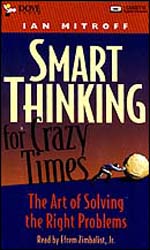 (Reprinted with permission of Training magazine, written by Rebbecca Ganzel.)
(Reprinted with permission of Training magazine, written by Rebbecca Ganzel.)
All across America, Ian Mitroff says in Smart Thinking for Crazy Times: The Art of Solving the Right Problems, executives are making bad decisions. They skimp on safety, then try to blame others for catastrophe (Exxon’s response to the 1989 Alaskan oil spill). They expand businesses that subsequently fail (Tandy Corp.’s “Incredible Universe” superstores). They make puns in ads that deeply offend some readers (a real estate agent’s “Schindler’s Listing” a chicken franchise’s “The Best Breasts in Southern California”). They heartlessly persist in making violent movies (Hollywood studios).
Why? Not because CEOs are crooked or greedy, or even too tired to think straight. No, the problem is simple: No one’s ever shown them a flow-chart of what correct decision-making looks like.
At least that’s how Mitroff, a business professor at the University of Southern California and author of seventeen previous books, sees it. And that’s the problem he sets out to solve in his new book.
Smart Thinking lays out five ways to make the wrong decision—or rather five paths to what statisticians call a “Type III error,” that of perfectly solving the wrong problem. (Mitroff calls it that, too. Unfortunately, he persists throughout the book in shortening the phrase to “E3,” as in, “Institution’s and whole societies...are capable of committing E3s”—a visual tic that may have been employed to lend an air of scientific veracity to the discussion.) The five pathways to error are:
•“Picking the wrong stake holders,” by which Mitroff primarily means ignoring public opinion.
•“Selecting too narrow a set of options,” usually a set more expensive than a better one that’s overlooked.
•“Phrasing a problem incorrectly,” often by failing to consider at least one “technical” and one “human” variable in stating a problem.
•“Setting the boundaries...of a problem too narrowly,” that is, failing to notice that the world passed from a “Machine Age” to a “Systems Age” forty years ago.
•“Failing to think systemically,” or ignoring the connection between part of the problem and its whole.
With charts, graphs, and critical-thinking exercises, and with a separate chapter devoted to overcoming each of these erroneous methods, Mitroff offers 159 pages of self-help to all those left-brained CEOs he imagines are looking for truth in all the wrong places. But the book doesn’t give much space to the gray areas of decision-making. It seems to escape the author altogether that the standards by which we judge one decision good and another bad are far from absolute.
To give just one of many examples, Mitroff takes it for granted that we will be as outraged as he is that, a couple of years ago, the Make-a-Wish Foundation (an organization that devotes itself to giving terminally ill children whatever experience they want most in the world) was prepared to grant what Mitroff styles the “offensive” wish of a dying teenage boy: to shoot a wild bear. Public opinion, fueled by animal rights activists, brought the foundation’s plans to a halt, but only after it had hired a safari club to fly the boy into the wilderness.
To Mitroff, to have hired the club at all was “a textbook case” of solving the wrong problem: “The Foundation could have redefined the notion of `shooting a bear’ to mean `shooting a picture of a beer,’ not literally taking its life, he says primly. “Then the problem would have been...helping the child to take a picture of the animal.”
But the boy didn’t want to be a photographer; he wanted to hunt. His chosen prey was unusual, but not illegal (the bear species wasn’t endangered). And while the case indeed sparked a media firestorm, public opinion was by no means unanimous. Nonetheless, with hindsight, Mitroff declares that, obviously, killing animals for sport is wrong; what was Make-a-Wish thinking?
Mitroff pays lip service, in his chapter on paradox, to the idea that there is more than one right way to solve a problem, but he is inflexible in imposing his two-dimensional ethics on the business world. Likewise, he is curiously insensitive to such fundamental American tenets as the right to privacy and freedom of expression—dismissing, for example, film executives’ arguments for making “distasteful” (but, of course, popular) movies as “an incredible mixture of truths, half-truths, distortions, and outright falsehoods.” In Mitroff’s view, if it offends someone, it’s bad. That code of conduct might work in a Sunday school, but it just doesn’t cut it in corporate America—and especially not in filmmaking and advertising, where pretty much anything (including the causes that Mitroff deems worthy of support, like AIDS activism) is going to ruffle somebody’s feathers.
Mitroff’s book presupposes that there are vast cadres of executives out there who need such naive advice. I’m not sure if that represents an inability to think systemically or a failure to expand the problem’s boundaries—but, whatever, it’s definitely an E3.
Appetizer
In today’s world, it is truly lame to believe that what one says behind closed doors or in private settings will remain there. The constant 24-hour-a-day, 365-day-a-year craving for news—everything everywhere is local news—has created a media monster whose appetite is voracious. What every public figure says is potentially page one news in the Los Angeles Times, Wall Street, Journal, New York Times or Washington Post; or a lead story on CNN or the six o’clock “Action News.” It is the height of arrogance, conceit and foolishness to think otherwise. Thus, the [error] is not only the tasteless joke or initial comment itself, but also the presumption that it will stay private and not see the light of day. Again and again, the problem is in the initial assumption that what is said will not create a problem!